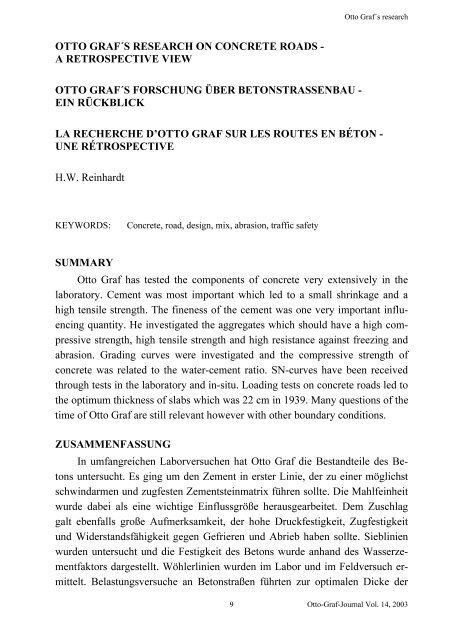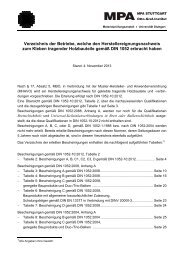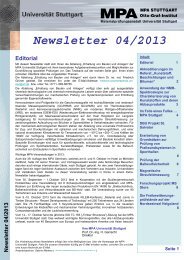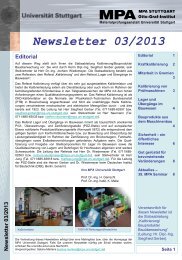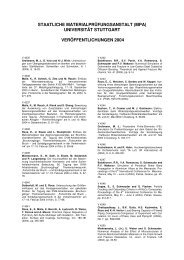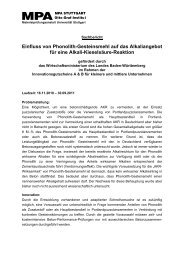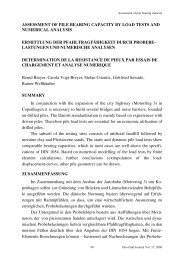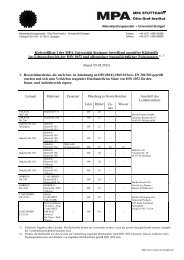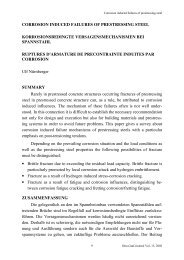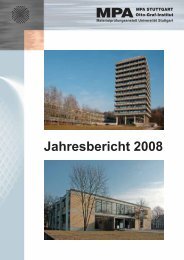OTTO GRAF´S RESEARCH ON CONCRETE ROADS - A ...
OTTO GRAF´S RESEARCH ON CONCRETE ROADS - A ...
OTTO GRAF´S RESEARCH ON CONCRETE ROADS - A ...
You also want an ePaper? Increase the reach of your titles
YUMPU automatically turns print PDFs into web optimized ePapers that Google loves.
<strong>OTTO</strong> <strong>GRAF´S</strong> <strong>RESEARCH</strong> <strong>ON</strong> C<strong>ON</strong>CRETE <strong>ROADS</strong> -<br />
A RETROSPECTIVE VIEW<br />
<strong>OTTO</strong> <strong>GRAF´S</strong> FORSCHUNG ÜBER BET<strong>ON</strong>STRASSENBAU -<br />
EIN RÜCKBLICK<br />
9<br />
Otto Graf´s research<br />
LA RECHERCHE D’<strong>OTTO</strong> GRAF SUR LES ROUTES EN BÉT<strong>ON</strong> -<br />
UNE RÉTROSPECTIVE<br />
H.W. Reinhardt<br />
KEYWORDS: Concrete, road, design, mix, abrasion, traffic safety<br />
SUMMARY<br />
Otto Graf has tested the components of concrete very extensively in the<br />
laboratory. Cement was most important which led to a small shrinkage and a<br />
high tensile strength. The fineness of the cement was one very important influencing<br />
quantity. He investigated the aggregates which should have a high compressive<br />
strength, high tensile strength and high resistance against freezing and<br />
abrasion. Grading curves were investigated and the compressive strength of<br />
concrete was related to the water-cement ratio. SN-curves have been received<br />
through tests in the laboratory and in-situ. Loading tests on concrete roads led to<br />
the optimum thickness of slabs which was 22 cm in 1939. Many questions of the<br />
time of Otto Graf are still relevant however with other boundary conditions.<br />
ZUSAMMENFASSUNG<br />
In umfangreichen Laborversuchen hat Otto Graf die Bestandteile des Betons<br />
untersucht. Es ging um den Zement in erster Linie, der zu einer möglichst<br />
schwindarmen und zugfesten Zementsteinmatrix führen sollte. Die Mahlfeinheit<br />
wurde dabei als eine wichtige Einflussgröße herausgearbeitet. Dem Zuschlag<br />
galt ebenfalls große Aufmerksamkeit, der hohe Druckfestigkeit, Zugfestigkeit<br />
und Widerstandsfähigkeit gegen Gefrieren und Abrieb haben sollte. Sieblinien<br />
wurden untersucht und die Festigkeit des Betons wurde anhand des Wasserzementfaktors<br />
dargestellt. Wöhlerlinien wurden im Labor und im Feldversuch ermittelt.<br />
Belastungsversuche an Betonstraßen führten zur optimalen Dicke der<br />
Otto-Graf-Journal Vol. 14, 2003
H. W. REINHARDT<br />
Platten, die schließlich auf 22 cm festgesetzt wurde. Viele Fragestellungen von<br />
damals sind auch heute noch aktuell, allerdings mit neuen Randbedingungen.<br />
RESUMÉ<br />
Des essais de laboratoire ont été exécutés par Otto Graf dans une large mesure<br />
pour étudier les composants du béton. Une place importante tenait la recherche<br />
d’un ciment qui montre un petit retrait et une grande résistance à la tension,<br />
une fois durci. Une grandeur importante semblait la finesse de mouture du<br />
ciment. Grande attention etait aussi donnée aux agrégats qui devraient avoir une<br />
grande résistance contre le gel et l’abrasion. La granulometrie du sable et des<br />
agrégats a été explorée et on a donné la résistance de compression comme fonction<br />
du rapport eau-ciment. Graf a déterminé des lignes Wöhler dans le laboratoire<br />
et in-situ. Des essais de chargement des dalles en béton menaient à<br />
l’épaisseur optimale qui a été fixée à 22 cm finalement. Beaucoup de questions<br />
posées à cette époque sont encore de l’actualité, pourtant avec des conditions<br />
nouvelles.<br />
INTRODUCTI<strong>ON</strong><br />
Otto Graf was a pioneer in the field of concrete roads. He has published 53<br />
papers on the subject. He was member of the relevant committees in Germany<br />
and has influenced the development of concrete roads very strongly. His work<br />
covers concrete technology, design, and traffic safety.<br />
C<strong>ON</strong>CRETE TECHNOLOGY<br />
In 1927, he published a paper on the general requirements on road concrete.<br />
There were seven items mentioned: 1. high compressive and high impact<br />
strength, 2. high tensile strength to avoid cracks, 3. small shrinkage and swelling,<br />
4. high abrasion resistance, 5. weather resistance, also with repeated freezing<br />
and thawing in saturated condition, 6. elasticity with reversible and irreversible<br />
deformation, 7. high resistance against chemical attack [1]. It follows<br />
that a concrete with crushed ductile rock as aggregate is suited for concrete. The<br />
concrete should have a minimum compressive strength of 30 MPa at the age of<br />
28 days. The mortar content should not exceed 55% and the concrete should be<br />
cured for a long period.<br />
10
Otto Graf´s research<br />
He states also that concrete with a large amount of coarse aggregate does<br />
less shrink than another one with a high content of fine material. However, the<br />
workability of the concrete should be improved [2]. Fig. 1 shows a concrete<br />
cross-section with 26% by vol. sand in the aggregates [3].<br />
Fig. 1. Concrete cross-section with 26% by vol. sand in the aggregates [3]<br />
The use of cement is a very important subject and Otto Graf has formulated<br />
seven questions at the beginning of a publication in 1935 [4]:<br />
1. Which properties define the quality of a cement for concrete roads?<br />
2. Are the results of standard tests on cement sufficient for the assessment of<br />
the suitability?<br />
3. Which tests are necessary additionally to standard testing?<br />
4. How do we find suitable cements for concrete roads?<br />
5. How can the consumer judge whether a delivered cement is especially suitable<br />
for concrete roads?<br />
6. How should the acceptance of cements be organised?<br />
7. Is the development of road cements only important for the road construction?<br />
He found that test results of standard tests are not sufficient to find out<br />
whether a cement is especially suited for concrete roads. He designed tests in<br />
which the specimens were stored in a cyclic moisture environment. Some cements<br />
were superior than others in the bending test. Obviously shrinkage influences<br />
the test results such that large shrinkage caused eigenstresses which low-<br />
11<br />
Otto-Graf-Journal Vol. 14, 2003
H. W. REINHARDT<br />
ered the bending strength. An important criterion is fineness of the cement. Fig.<br />
2 shows the influence of the fineness of the cement on the compressive strength,<br />
the bending strength, and on shrinkage.<br />
Fig. 2. Influence of fineness on the properties of cement [5] 1<br />
It is obvious that finer cement increases the compressive strength at 28<br />
days as well as the bending strength. However, a finer cement causes also an<br />
increase of shrinkage. Graf requires that the compressive strength of a cement<br />
should be 45 MPa at the age of 28 days and the bending strength should be at<br />
least 5.5 MPa. In [6], the requirements were given more precisely and Graf<br />
points on the cracking, for instance due to capillary stresses during the summer.<br />
He states already in 1937 [7] that the production control in the cement factory is<br />
as important as the standard testing independent laboratories.<br />
In 1935 [8] he published a paper on the most important parameters which<br />
determine the concrete strength. Fig. 3 shows the plot of the compressive<br />
strength of concrete as function of the water-cement ratio. It can be seen that the<br />
strength is mainly determined by the water-cement ratio. On the other hand, the<br />
scatter of results is important. He states also that the sand content of the concrete<br />
is important. Especially as the amount of sand exceeds 50%, the strength of concrete<br />
is much less.<br />
1 Throughout the paper the unit kg/cm 2 should be converted to 0.1 MPa.<br />
12
Otto Graf´s research<br />
Fig. 3. Compressive strength of concrete as function of the water-cement ratio<br />
Otto Graf carried out cyclic tests. He found that the concrete strength decreases<br />
due to cyclic testing, especially as the first million of cycles is concerned.<br />
The strength drops from the original value to about 80%. Fig. 4 shows<br />
the diagram which illustrates the reduction of compressive strength due to 5<br />
million cycles. It is a Goodman-diagram with the upper stress at the top of the<br />
figure.<br />
Fig. 4. Goodman-diagram of concrete [8]<br />
Shrinkage is of paramount importance for road concrete because it may<br />
cause large eigenstresses in a concrete slab. Graf investigated several cements<br />
and found in Fig. 5 that there are large differences as shrinkage of cement is<br />
concerned. Cement a shows a shrinkage of about 0.8 · 10 3 whereas cement e<br />
shows a shrinkage of 1.5 · 10 3 . As Fig. 5 shows that the tests lasted 10 years.<br />
13<br />
Otto-Graf-Journal Vol. 14, 2003
H. W. REINHARDT<br />
Fig. 5. Shrinkage of various cements [8]<br />
He investigated also different aggregates in concrete and found that the<br />
shrinkage of concrete with furnace slag is small whereas with granite shows a<br />
larger shrinkage. After drying the specimens where stored in water and there the<br />
swelling of concrete with limestone aggregate is larger than with all other aggregates.<br />
In 1936, there appeared a paper on the general properties and requirements<br />
on concrete roads [9]. Graf states that the compressive strength should be<br />
at least 40 MPa at the age of 28 days, the bending strength should be 4.5 MPa.<br />
The slab thickness of concrete roads should be at least 20 cm [10]. He carried<br />
out many in-situ tests in order to establish the relation between the slab thickness<br />
and the loading capacity. Fig. 6 shows an illustration of the loading devices<br />
used at that time. Cars were used as reaction load for the pistons which were<br />
mounted under the loading bridge. By using this device he could apply also cyclic<br />
load on the concrete road.<br />
14
Fig. 6. Loading device for cyclic in-situ tests<br />
15<br />
Otto Graf´s research<br />
DESIGN<br />
As stated before, Graf introduced his papers very often by asking questions<br />
[11]. As the design rules are concerned, he formulated three questions:<br />
a) What should be the thickness of concrete slabs for an axial load of 8 tons<br />
which occurs very often?<br />
b) Which are the stresses which occur in 15, 20 and 25 cm thick slabs under<br />
moving loads? What are the thermal stresses due to climatic changes?<br />
c) Which is the advisable width of joints between concrete slabs and what are<br />
the changes of joint width during a day and during a year?<br />
To that end tests have been carried out on the expressways München-<br />
Holzkirchen and Stuttgart-Ulm. After testing he decides to design concrete slabs<br />
with a thickness of 20 cm. He refers to publications of Westergaard in 1926<br />
[12]. He found that the strains which were predicted by Westergaard’s formulae<br />
were smaller than those which were measured in-situ. The measurement on joint<br />
widths showed that a mean value of 0.007 mm are most probable for a slab<br />
length of 1 m and a temperature difference of 1°C.<br />
Otto-Graf-Journal Vol. 14, 2003
H. W. REINHARDT<br />
The question whether concrete roads should be reinforced with steel was<br />
not decided yet [13]. Graf states that reinforcement is only an auxiliary measure<br />
since reinforcement cannot suppress cracking. Reinforcement acts when the<br />
concrete cracks and the cracking cannot be prevented. So, in the guidelines for<br />
the construction of concrete roads (ABB) [14] it is recommended that reinforcement<br />
should be used only where the subbase is very weak, for instance on<br />
high dams or infills. In these situations the reinforcement ratio should be 6-8<br />
cm 2 on the slab width of 3.75 m which is very low. In a later publication [15] the<br />
necessary steel cross-section is given with 0.5 to 1% of the concrete crosssection<br />
which is more realistic. There should be dowels in the joints. Otherwise,<br />
there will be steps on the concrete roads which impair the traffic safety [16]. In<br />
1950, Graf presented a paper which summarises the main questions but also the<br />
experiences which were made with the concrete road construction in Germany<br />
[17].<br />
TRAFFIC SAFETY<br />
Tests were carried out on the friction resistance of concrete roads. To that<br />
end a measuring device was designed as a roundabout which is depicted in Fig.<br />
7 [18].<br />
Fig. 7. Measuring device for the testing of friction between wheel and concrete [19]<br />
16
17<br />
Otto Graf´s research<br />
A dry road led to a friction coefficient of 0.63, a wet surface to 0.41 and a<br />
slippery road (= dirty) to 0.33. During the test duration the friction coefficient<br />
increased.<br />
C<strong>ON</strong>CLUSI<strong>ON</strong><br />
Otto Graf was an exceptional personality [20, 21, 22]. Besides the already<br />
mentioned 53 publications on concrete road he published 570 papers on other<br />
subjects like reinforced concrete, steel structures and timber structures. Besides<br />
his scientific achievements he was a very practical organiser whose testing and<br />
research was mainly funded by industry. He was a member of several committees<br />
in all areas. So it was possible to publish a guideline for the construction of<br />
concrete roads already in 1939 which was a milestone in concrete road construction.<br />
The quality of German expressways was very good and the durability<br />
was high. At that time it was a challenge to work in this area. To acknowledge<br />
his achievements the civil engineering division of the MPA got the name Otto-<br />
Graf-Institute in 1953.<br />
REFERENCES<br />
[1] Graf, O.: Beton für den Straßenbau. Betonstraße 2 (1927) H. 9, S. 204-<br />
205<br />
[2] Graf, O.: Über einige Bedingungen für die Herstellung von gutem<br />
Straßenbeton, Zement 23 (1934) H. 41, S. 610-613; H. 42, S. 626-628<br />
[3] Graf, O.: Über einige Bedinungen für die Herstellung von gutem Straßenbeton.<br />
Betonstraße 9 (1934) H. 11, S. 185-189<br />
[4] Graf, O.: Über die Prüfung, Auswahl und Abnahme der Zemente für den<br />
Straßenbau. Beton und Eisen 34 (1935) H. 6, S. 89-93<br />
[5] Graf, O.: Über Zement für Betonstraßen. Zement 24 (1935) H. 23, S. 347-<br />
351; H. 24, S. 363-367<br />
[6] Graf, O.: Über die Auswahl der Zemente zum Betonstraßenbau und über<br />
dabei aufgetretene Fragen. Zement 25 (1936) H. 33, S. 549-556<br />
Otto-Graf-Journal Vol. 14, 2003
H. W. REINHARDT<br />
[7] Graf, O.: Bemerkungen und Feststellungen zur Prüfung der Straßenbauzemente.<br />
Zement 26 (1937) H. 45, S. 729-732; H. 46, S. 743-747; H. 47,<br />
S. 759-764<br />
[8] Graf, O.: Erkenntnisse über Straßenbeton. Zusammengestellt aus Versuchen<br />
in der Materialprüfanstalt der TH Stuttgart (Abt. Bauwesen), Berlin<br />
Zementverlag 1935<br />
[9] Graf, O.: Betonstraßenbau und Materialprüfung. Straße 3 (1936) H. 2, S.<br />
52-56<br />
[10] Graf, O.: Forschungsarbeiten für die Reichskraftfahrbahnen. Bauzeitung<br />
49 (1937) H. 12, S. 164-166<br />
[11] Graf, O.: Aus Versuchen mit Betondecken der Reichskraftfahrbahnen,<br />
durchgeführt in den Jahren 1934 und 1935. Betonstraße 11 (1936) H. 9, S.<br />
193-203; H. 10, S. 235-241; H. 11, S. 272-281<br />
[12] Westergaard, H.M.: Public roads 1926, Vol. 7, S. 25 und Public roads<br />
1927, Vol. 8, S. 54<br />
[13] Graf, O.: über die zweckmäßige Bewehrung der Betonfahrbahnplatten.<br />
Betonstraßen 11 (1936) H. 7, S. 150-151<br />
[14] Anweisung für den Bau von Betonfahrbahndecken (ABB), Berlin 1939<br />
[15] Weil, G.: Zur Frage der Spannungen und Bewehrungen in Betonfahrbahnplaten,<br />
in O. Graf (Hrsg.) Beobachtungen an Betonfahrbahndecken,<br />
Forsch. Ges. für das Straßenwesen, Arbeitsgruppe Betonstraßen, Kirschbaum-Verlag,<br />
Bielefeld 1952, S. 32-45<br />
[16] Graf, O.: Über die Widerstandsfähigkeit von Rundeisendübeln an den<br />
Querfugen von Betonfahrbahndecken. In: Jahrbuch 1936 der Forschungsgesellschaft<br />
für das Straßenwesen e.V. Berlin: Volk und Reich<br />
Verlag 1936, S. 145-166<br />
[17] Graf, O.: Über den derzeitigen Stand der Forschung für den Betonstraßenbau.<br />
Straße und Autobahn 1 (1950) H. 6, S. 35-37; ebenso im<br />
Tätigkeitsbericht 1949/1950 der Forschungsgesellschaft für das Straßenwesen,<br />
S. 39-43<br />
[18] Graf, O.: Aus Untersuchungen über die Reibung von Kraftwagenreifen<br />
auf Straßen und über die Abnutzung der Straßendecken. Beton und Eisen<br />
33 (1934) H. 1, S. 7-8<br />
18
Otto Graf´s research<br />
[19] Weil, G. Über die Reibungsbeiwerte zwischen Rad und Fahrbahn. Mitt.<br />
der Versuchsanstalt für Straßenbau, TH Stuttgart, H. 9, 1934<br />
[20] Otto Graf 50 Jahre Forschung, Lehre, Materialprüfung im Bauwesen.<br />
1903-1953, Abt. Bauingenieur- und Vermessungswesen der TH Stuttgart,<br />
1953<br />
[21] Rehm, G.: Otto Graf - ein Genie? VDI Gesellschaft Bautechnik, Jahrbuch<br />
1993, S. 489-529<br />
[22] Reinhardt, H.-W.: Graf, Otto, Maximilian, Bauforscher. In. Ottnad, Bernd<br />
(Hrsg.): Baden-Württembergische Biographien, Band II. Stuttgart: W.<br />
Kohlhammer, 1999, S. 167-169<br />
19<br />
Otto-Graf-Journal Vol. 14, 2003
H. W. REINHARDT<br />
20


